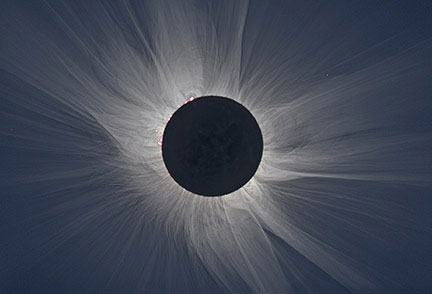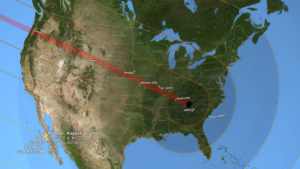
The sky darkens in the middle of the day. The birds stop singing. Insects get quiet. A pearly white corona emanates from the dark circle that covers the sun. Planets and stars become visible in the sky.
“A total eclipse of the sun is a very rare and beautiful event that you can only really enjoy from within the path of totality,” said Gerard Williger, PhD, associate professor in the Department of Physics and Astronomy at the University of Louisville. “It’s as though the sun was taken away for a couple of minutes and then it comes back and it’s all better afterward.”

Kentuckians will have the opportunity to experience that rare and beautiful event on August 21, when the moon will pass directly between the sun and the earth, eclipsing the sun’s light for about two minutes. The 2017 Solar Eclipse path of totality, a 70-mile-wide swath of Earth that lies in the eclipse’s full shadow, will cross the southeastern corner of Kentucky, passing over Hopkinsville and Paducah, in a line stretching from South Carolina to Oregon.
At this month’s Beer with a Scientist event, Williger will share the wonder of the total eclipse experience, explain exactly how rare it is, and provide guidance on safe viewing of the eclipse. Yes, special equipment is required, but it isn’t costly.
The event begins at 8 p.m. on Wednesday, May 17, at Against the Grain Brewery, 401 E. Main St. in Louisville. A 45-minute presentation will be followed by an informal Q&A session.
Also in the double-header discussion, Nick Duong will discuss recent research on near-Earth asteroids (NEAs) and share what we know about their likelihood of striking the Earth. Duong, a recent UofL graduate, worked with the SETI Institute to study and map Asteroid 1992 UY4. SETI, which stands for Search for Extra-Terrestrial Intelligence, is a private institute that researches life in the universe.
The University of Louisville Department of Physics and Astronomy has created a web page about the eclipse, including viewing events sponsored by UofL for students, alumni and the public.
Admission to Beer with a Scientist is free. Purchase of beer, other beverages or menu items is not required but is encouraged.
For more information and to suggest future Beer with a Scientist topics, follow Louisville Underground Science on Facebook. Upcoming dates:
- June 14 – Jacquelyn Graven, Graven and Assoc. – How to work less and play more
- July 12 – Lee Dugatkin of UofL – How to tame a fox and build a dog
































